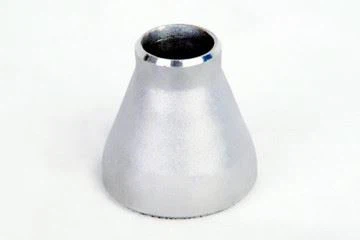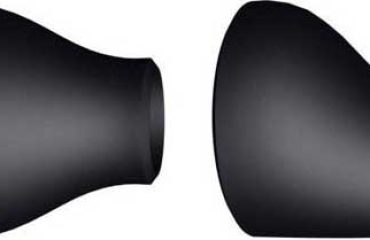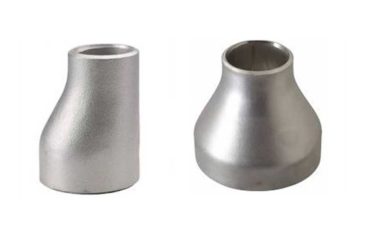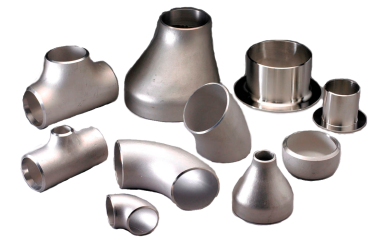
Diseksi Mendalam pada Nilai Tertentu
WP304 dan WP304H
WP304: Kelas ini adalah baja tahan karat yang paling banyak digunakan, dikenal karena keserbagunaan dan keseimbangan propertinya. Ini menawarkan ketahanan yang sangat baik terhadap korosi di lingkungan atmosfer dan banyak media korosif. Sifat mekanik dan sifat mampu bentuk yang baik membuatnya cocok untuk berbagai aplikasi, Dari peralatan dapur hingga pemrosesan kimia.
WP304H: Versi WP304 yang tinggi karbon, WP304H dirancang untuk aplikasi suhu tinggi. Kandungan karbon yang meningkat meningkatkan kekuatannya pada suhu di atas 500 ° C (932° F). Aplikasi umum termasuk boiler dan komponen penukar panas.
WP309
WP309 Stainless Steel mengandung kadar kromium dan nikel yang lebih tinggi dibandingkan dengan WP304, memberikan resistensi oksidasi yang unggul. Tingkat ini sering digunakan di lingkungan di mana suhu tinggi dan kondisi korosif hidup berdampingan, seperti bagian tungku, Oxidizer termal, dan penukar panas.
WP310
WP310 adalah tingkat resisten suhu tinggi lainnya, dengan kandungan kromium dan nikel yang lebih tinggi dari WP309. Ini mempertahankan resistensi yang sangat baik terhadap oksidasi dan korosi di lingkungan hingga 1100 ° C (2012° F). Aplikasi tipikal termasuk komponen tungku, Keranjang perlakuan panas, dan peralatan pemrosesan kimia.
WP316 dan WP316L
WP316: Dimasukkannya molibdenum dalam WP316 meningkatkan resistensi terhadap pitting klorida dan korosi celah, menjadikannya ideal untuk lingkungan laut dan kimia. Ini biasanya digunakan dalam peralatan farmasi dan pengolahan makanan, serta dalam aplikasi arsitektur pesisir.
WP316L: Varian rendah karbon dari WP316 menawarkan peningkatan las dan mengurangi risiko curah hujan karbida selama pengelasan. Ini membuatnya menjadi pilihan yang disukai untuk aplikasi yang dilas di lingkungan yang keras, seperti tangki kimia dan sistem pipa.
WP317L
WP317L Stainless Steel mengandung kandungan molibdenum yang lebih tinggi dari WP316, memberikan resistensi yang lebih baik terhadap korosi pitting dan celah. Ini digunakan dalam lingkungan yang sangat korosif seperti pemrosesan kimia, petrokimia, dan industri farmasi.
WP321
WP321 distabilkan dengan titanium, yang mencegah pembentukan kromium karbida pada suhu tinggi, dengan demikian meningkatkan ketahanannya terhadap korosi intergranular. Ini cocok untuk aplikasi yang melibatkan pemanasan terus menerus dan intermiten, seperti manifold knalpot dan komponen dirgantara.
WP347
Mirip dengan WP321, WP347 distabilkan, Tapi dengan Columbium (Niobium). Tingkat ini menawarkan resistensi yang sangat baik terhadap korosi intergranular dan umumnya digunakan dalam pemrosesan kimia suhu tinggi dan aplikasi pembangkit listrik.
WP904L
WP904L adalah baja stainless austenitic paduan tinggi dengan ketahanan korosi yang luar biasa, terutama terhadap lingkungan asam sulfat dan klorida. Konten nikel dan molibdenum yang tinggi, bersama dengan penambahan tembaga, Tingkatkan ketahanannya terhadap korosi pitting dan celah. Aplikasi tipikal termasuk perangkat pendingin air laut, Pemrosesan kimia, dan komponen kilang minyak.
Skenario Penggunaan Detail
Pemrosesan kimia
Di industri kimia, Resistensi terhadap berbagai asam dan klorida sangat penting. Nilai seperti WP316, WP316L, WP317L, dan WP904L lebih disukai untuk resistensi korosi superior mereka. Bahan -bahan ini digunakan dalam reaktor, tangki penyimpanan, dan sistem perpipaan di mana paparan bahan kimia yang keras adalah umum.
industri minyak dan gas
Sektor minyak dan gas menuntut bahan yang dapat menahan tekanan tinggi, suhu, dan lingkungan yang korosif. WP304H, WP309, WP310, dan WP347 sering digunakan dalam industri ini. Mereka ditemukan dalam aplikasi seperti komponen kilang, saluran pipa, dan peralatan pengeboran lepas pantai.
Aplikasi Kelautan
Lingkungan laut sangat korosif, terutama karena adanya klorida. WP316, WP316L, dan WP904L sangat ideal untuk kondisi seperti itu. Mereka digunakan dalam pembuatan kapal, Struktur Lepas Pantai, dan tanaman desalinasi.
pembangkit listrik
Pembangkit listrik membutuhkan bahan yang dapat menahan suhu dan tekanan tinggi. WP321 dan WP347 sangat cocok untuk aplikasi ini karena stabilitas dan ketahanannya terhadap korosi intergranular. Mereka digunakan dalam komponen boiler, Penukar Panas, dan bagian turbin.
Industri Makanan dan Minuman
Sanitasi dan resistensi korosi adalah yang terpenting dalam industri makanan dan minuman. WP304 dan WP316 biasanya digunakan karena non-reaktivitasnya dengan zat makanan dan kemudahan pembersihan. Aplikasi termasuk peralatan pengolahan makanan, tangki penyimpanan, dan perpipaan.
Ringkasan
Pengurangan stainless steel sesuai dengan nilai WP ASTM A403 menawarkan beragam properti yang disesuaikan dengan kebutuhan industri tertentu. Pemilihan nilai yang sesuai tergantung pada faktor -faktor seperti resistensi korosi, Ketahanan Suhu, Sifat mekanik, dan kemampuan las. Memahami manfaat dan aplikasi unik dari setiap kelas memastikan kinerja yang optimal dan umur panjang sistem perpipaan di berbagai industri.
Referensi
- ASTM A403/A403M: Spesifikasi Standar untuk Perlengkapan Pipa Stainless Steel Austenitik Tempa.
- ASM Internasional: Buku Pegangan Baja Tahan Karat.
- NACE Internasional: Dasar-Dasar Korosi: Sebuah Pengantar.
- Sastra Teknis: Sifat material dan proses pembuatan reduksi baja tahan karat.
- Laporan Pasar: Tren dan perkiraan untuk industri baja tahan karat.
Dokumen komprehensif ini harus memberikan pemahaman menyeluruh tentang peredam stainless steel di ASTM A403 WP Nilai, memandu pemilihan dan penerapan bahan -bahan ini dalam berbagai konteks industri.
Proses manufaktur terperinci
Untuk sepenuhnya memahami kemampuan dan keterbatasan ASTM A403 WP Stainless Steel Reducers, Sangat penting untuk mempelajari proses pembuatan yang terlibat. Proses -proses ini sangat mempengaruhi sifat mekanik, Struktur mikro, dan secara keseluruhan kualitas dari produk akhir.
penempaan
penempaan adalah metode umum yang digunakan untuk memproduksi peredam stainless steel. Proses ini melibatkan pemanasan baja hingga suhu tinggi dan kemudian membentuknya menggunakan gaya tekan. Forging meningkatkan struktur biji -bijian, menghasilkan sifat mekanik yang ditingkatkan, termasuk kekuatan dan ketangguhan.
- Penempaan terbuka: Melibatkan mendeformasi logam antara beberapa dies yang tidak sepenuhnya melampirkan material. Itu cocok untuk besar, bentuk khusus.
- Penempaan tertutup: Memanfaatkan mati yang sepenuhnya melampirkan material, memungkinkan bentuk yang tepat dan konsisten. Metode ini sangat ideal untuk produksi volume tinggi reduksi yang lebih kecil.
permesinan
permesinan sering digunakan untuk mencapai dimensi akhir dan toleransi yang diperlukan untuk peredam stainless steel. Proses ini melibatkan menghilangkan bahan dari benda kerja menggunakan alat pemotongan.
- Berbalik: Digunakan untuk membuat bagian silinder dengan memutar benda kerja terhadap alat pemotong.
- Penggilingan: Melibatkan penggunaan alat pemotong berputar untuk menghilangkan bahan dan membuat permukaan datar atau kompleks.
- Pengeboran dan mengetuk: Penting untuk membuat lubang dan benang di peredam.
perawatan panas
perawatan panas Proses sangat penting dalam meningkatkan sifat mekanik dan ketahanan korosi peredam stainless steel. Metode perlakuan panas yang umum termasuk:
- Anil: Melibatkan pemanasan baja ke suhu tertentu dan kemudian secara perlahan mendinginkannya. Proses ini mengurangi tekanan internal, meningkatkan daktilitas, dan menyempurnakan struktur mikro.
- Solusi Annealing: Khusus untuk baja tahan karat austenitic, Proses ini melarutkan karbida yang diendapkan, meningkatkan ketahanan korosi.
welding
welding sering diperlukan untuk bergabung dengan peredam stainless steel ke komponen lain dalam sistem perpipaan. Proses pengelasan harus dikendalikan dengan cermat untuk mencegah masalah seperti curah hujan karbida, yang dapat membahayakan resistensi korosi.
- CEKCOK (Gas Inert Tungsten) welding: Menawarkan kontrol yang tepat dan tinggi-kualitas lasan, membuatnya cocok untuk bagian tipis dan aplikasi penting.
- AKU (Gas Inert Logam) welding: Memberikan kecepatan pengelasan yang lebih cepat dan cocok untuk bagian yang lebih tebal.
Penyelesaian Permukaan
Penyelesaian Permukaan Proses sangat penting untuk meningkatkan penampilan, Tahan korosi, dan kebersihan peredam stainless steel.
- Pengawetan dan Pasifasi: Melibatkan menghilangkan kontaminan permukaan dan sisik oksida, diikuti dengan pasif untuk mengembalikan lapisan kromium oksida pelindung.
- Electropolishing: Proses elektrokimia yang menghaluskan dan memoles permukaan, Meningkatkan resistensi korosi dan mengurangi risiko kontaminasi.
Kontrol Kualitas dan Pengujian
Memastikan kualitas dan kinerja peredam stainless steel adalah yang terpenting. Berbagai langkah pengujian dan kontrol kualitas diimplementasikan di seluruh proses pembuatan.
Analisis kimia
Analisis kimia memverifikasi komposisi stainless steel, memastikannya memenuhi persyaratan nilai yang ditentukan. Teknik seperti spektroskopi emisi optik (Oes) dan fluoresensi x-ray (Xrf) umum digunakan.
Pengujian Mekanis
Pengujian Mekanis menilai kekuatan, keuletan, dan ketangguhan material. Tes umum meliputi:
- Pengujian Tarik: Mengukur respons material terhadap kekuatan tarik, Memberikan data tentang kekuatan luluh, Kekuatan Tarik, dan perpanjangan.
- Pengujian Kekerasan: Menentukan ketahanan material terhadap lekukan dan keausan.
- Pengujian Dampak: Mengevaluasi ketangguhan material, khususnya pada suhu rendah.
Pengujian non destruktif (NDT)
Pengujian non destruktif Metode digunakan untuk mendeteksi cacat permukaan dan bawah permukaan tanpa merusak material. Metode NDT yang umum meliputi:
- Pengujian Ultrasonik (OUT): Menggunakan gelombang suara frekuensi tinggi untuk mendeteksi kelemahan internal.
- Pengujian Radiografi (RT): Menggunakan sinar-X atau sinar gamma untuk mengungkapkan cacat internal.
- pewarna pengujian penetran (DPT): Digunakan untuk mendeteksi retak dan cacat permukaan.
Inspeksi Dimensi
Inspeksi Dimensi memastikan bahwa peredam memenuhi dimensi dan toleransi yang ditentukan. Teknik seperti mesin pengukur koordinat (CMM) dan kaliper biasa digunakan.
Kesimpulan
Pemilihan dan penerapan peredam baja stainless ASTM A403 WP memerlukan pemahaman menyeluruh tentang berbagai tingkatan, Properti mereka, dan proses pembuatan yang terlibat. Dengan mempertimbangkan faktor -faktor seperti resistensi korosi, Sifat mekanik, dan persyaratan aplikasi tertentu, Industri dapat memastikan kinerja yang optimal dan umur panjang sistem perpipaan mereka.
Referensi
- ASTM A403/A403M: Spesifikasi Standar untuk Perlengkapan Pipa Stainless Steel Austenitik Tempa.
- ASM Internasional: Buku Pegangan Baja Tahan Karat.
- NACE Internasional: Dasar-Dasar Korosi: Sebuah Pengantar.
- Sastra Teknis: Sifat material dan proses pembuatan reduksi baja tahan karat.
- Laporan Pasar: Tren dan perkiraan untuk industri baja tahan karat.
Panduan komprehensif ini harus memberikan wawasan berharga tentang dunia rumit reduser stainless steel yang rumit, membantu dalam seleksi, Aplikasi, dan jaminan kualitas komponen kritis ini di berbagai industri.




Kamu harus login untuk mengirim komentar.